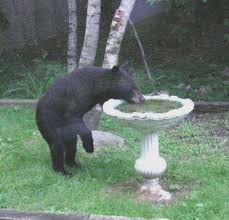I could have gone to a hundred different places. But for some reason I was drawn to a place that I have not visited in 15 years. As I drove to this area I felt isolated, surrounded by towering white pines on either side of the car, dust flying up behind me, insects banging on the car windows and hood, sometimes sounding like large solitary raindrops hitting the car. ‘Good thing I wasn’t walking through this’, I thought to myself. I would have been bitten by horseflies, mosquitoes and no-see-ums. The road narrowed and I was now driving over tall grass that brushed the bottom of the car and the sound of a constant high pitched “thrash” seemed to be coming from the bottom of my feet. If I was Fred Flintstone, I would have needed DEET on my legs to keep the ticks off.
As I ended the long straight drive through thick, dark forest I turned left around the only curve over the past three miles. Suddenly, the landscape changed and I found myself driving past a brilliant, eye-squinting sand pit on my right bordered by a large stand of dark forest. On my left there was a huge wide meadow with chest high tawny grass blowing gently in the morning breeze. A hawk screeched from above the field. Probably upset with this large vehicle disturbing its morning hunt. At the end of the grassy road I saw a pup slowly emerge from the forest. Gray fox? Red fox? Wolf pup? Something was not right. Its face reminded me of Dobby from Harry Potter. Was this some sort of house elf genetic experiment gone wrong? Nope. Just a coyote pup. But not your average happy go lucky coyote puppy. This puppy had seen hard times. And it showed this with its haunting black eyes. 

As it sauntered towards my car, I was amazed that it had not scampered away into the dense forest. As I quickly reached for my camera, I knew that I had a few seconds to take a picture before instinct told it to run from this huge, engine-whirring monster. But I was dead wrong. This pup was not afraid of a 2000 pound car. It had other things on its mind. It must have had little sleep, because it stopped every few seconds to bite and scratch at a different part of its body. Its eyes looked right through me. I felt its despair. The coyote pup lowered its ears and then quickly perked them up if an insect buzzed by. I watched it catch and chew a small flying insect that literally flew right into its mouth. This carnivore was definitely starving. I took a few more pictures and then watched as it leaped into the woods to chase some unknown sound. I had a strong feeling that it was an orphan. And I know that orphaned animals do not last long in the wild. 

Even so, this rarely happens. I have seen coyotes before but never a coyote cub. Most animals hide and watch as you hike by. This was such a unique experience that I brought my daughter to the same spot later that afternoon. I just wanted to show her where I saw the pup and teach her about the tracks and the coyote scat I found nearby. But again, as I turned left around that corner, the coyote pup was there! Right in the middle of the road and it was eating an unusually large gray squirrel. The pup grabbed its meal and moved it under several pine trees to protect it against me or any other predator that may want to take it away. But as it was moving its catch, something caught my eye. Its food was not a gray squirrel. It looked just like the coyote cub itself. The gray scraggly hair, long thin legs and black pointy nose; it must have been a sibling. No wonder its black eyes looked right through me earlier that morning. Starvation was forcing it to consume a fellow pup that it probably played with just a few months earlier. If I was that hungry, I would not have been afraid of a 2000 pound engine-whirring monster either. 















